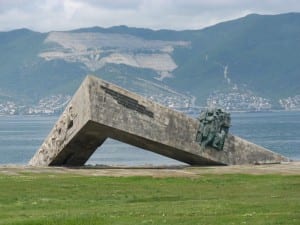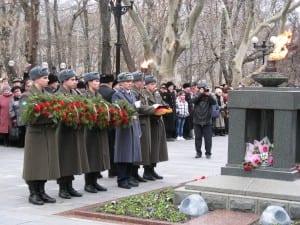Remembering the war: 70 years on in the Hero-City of Novorossiisk
By Sarah J Young, on 9 May 2013
Local war commemoration in Russia persists through the invention of tradition, finds postgraduate student Vicky Davis.
Over the last decade, remembrance of World War II in Russia has become increasingly visible in a state-sponsored revival of the war cult of the Brezhnev era. On significant anniversaries, notably Victory Day, 9th May, Russians celebrate in a series of special events, the most well known of which is the massive military parade on Moscow’s Red Square. Honoured veterans don their uniforms and are showered with gifts and privileges, proof of their special status in society. Most people wear the popular symbol of memory introduced in 2005, the George ribbon, and even those staying at home cannot escape the programme of war films and music around that date. The President makes speeches and takes tea with veterans, confident that memory of the war is the one theme that cannot fail to unify the country. It seems that, in Russia, memory of the war has been re‑appropriated as a political tool, just as living witnesses are rapidly disappearing, rendering it increasingly the subject of scholarly research.
It is not surprising that on 2nd February this year President Putin and the world’s press were gathered in the Russian city of Volgograd. Formerly known as Stalingrad, the city was celebrating the seventieth anniversary of the defeat and final surrender of the enemy in 1943 after months of bitter struggle, marking the pivotal point of what Russians call the Great Patriotic War. Stalingrad was one of the first of the thirteen towns honoured as Hero-Cities of the Soviet Union for their significant role in the war.
On the day following the Stalingrad ceremonies, commemorations were also held in Novorossiisk, on the Black Sea, made a Hero-City of the Soviet Union in 1973, long after the end of the war, thanks to the involvement in its liberation of Leonid Brezhnev, the former Soviet leader. In turn, Novorossiisk was remembering the seventieth anniversary of the landings onto occupied territory by Soviet troops, who went on to hold the small beach‑head, known as ‘Malaia zemlia’, for seven months prior to the liberation of the town in September 1943. The heroes of this localised campaign are commemorated through an amalgam of memoir, monuments and ritual, rendered particularly paradoxical by the discrepancy between the relative insignificance of the actual campaign as it unfolded at the time and the importance attributed to it retrospectively thanks to Brezhnev’s inflated war memoirs.
As the war in Novorossiisk, and indeed in Russia as a whole, is on the cusp of the transition from living memory to history, my research project analyses the relationship and interaction between different forms of memorialization in the construction and propagation of present‑day inter‑generational remembrance in Novorossiisk. I had planned this year’s trip to coincide with the seventieth anniversary of the Malaia zemlia landings on the night of 3rd to 4th February, which are commemorated annually in a ceremony unique to the town, ‘Beskozyrka’. In 1968, at the beginning of the Brezhnev era, this ritual was invented to mark the 25th anniversary of the landings by a group of young people in search of romantic adventure and forming the ‘crew’ of an imaginary yacht, the ‘Shkhuna rovesnikov’ (the Schooner of fellows).
Despite several well-meaning warnings about the severity of the weather at that time of year, as the ‘nord‑ost’ wind whistles down to the sea from the foothills of the Caucasus mountains, I decided to attend the rituals of remembrance with the town’s community. This year’s 45th anniversary of ‘Beskozyrka’ started with a solemn remembrance ceremony at the Eternal Flame on Heroes’ Square (pictured). As dusk fell, the crowds joined a torchlit procession to the exact spot of the landings, following the tank carrying a sailor’s hat, the beskozyrka, a symbol of those who lost their lives that night in 1943. Candles placed on windowsills inside flats along the way showed their solidarity with the marchers. Arriving finally on the sea-shore next to the Malaia zemlia memorial, a monument in the shape of the prow of a landing boat whose sides are covered with the sculpted figures of Soviet troops bearing machine-guns and grenades, the beskozyrka was placed on a wreath of flowers and carefully carried into the sea by a young soldier, a modern-day hero, who waded out into the cold water up to his shoulders to deposit the garland and the hat on the waves.
This Soviet ritual has survived over the years, resisting sweeping political, economic and social changes towards the end of the twentieth century to become even more successful today than in the Brezhnev era, apparently flourishing in the memorial environment of the Putin-era war cult. Thanks to a series of changes and additions, it has been kept alive and relevant, rendered more attractive to families, children and veterans alike. Indeed, this year’s addition to the programme was an early afternoon ceremony for children, including a reconstruction of the landings. The record 23,500 participants this year are proof that there is a will to retain this ritual of remembrance which marks the identity of Novorossiisk. (A full report in Russian may be found on the website of the local newspaper.)
During the 120 individual interviews I have conducted over a period of three years as part of my research into perceptions of war remembrance, I have found that sharing a cup of tea with the respondent breaks the ice. It has also become apparent that men have more difficulty in relaxing into conversation about their attitude to memory than women. When interviewing elderly or potentially vulnerable subjects, I take along somebody to help them feel more at ease, often a friend, relation or member of the local Veterans’ Association. As an outsider, I do not normally meet much suspicion (except the time I was accused of being a spy!), rather a feeling of inadequacy in some respondents that they may not give the ‘correct’ answers. Once they realise that I am just a normal person interested in their attitude to memory, they mostly start to trust me with their own experiences, many returning with additional snippets of information or material of interest; they seem to be quite excited to be taking part in a project to inform people in the West about their provincial town and its history, some indeed realising that only an outsider can obtain an objective overview of the subject. I feel privileged to have spent time in discussion with several war veterans and grateful for the candid response of all my respondents, even if some answers seem rehearsed.
The highlight of my visit to Novorossiisk this February was the opportunity to interview the founding captain of the ‘Shkhuna rovesnikov’, Konstantin Podyma. On this occasion, I was accompanied by the Deputy Mayor of Novorossiisk, Natal’ia Maiorova, while Podyma himself was flanked by two of his fellow Shkhunatiki from the Brezhnev era. Over cups of tea and chocolates I heard the story of how the Beskozyrka ceremony developed in the first years, thanks to the support of veterans and the local newspaper, Novorossiiskii rabochii. The early Beskozyrka tradition was apparently welcomed by both young and old, fusing the patriotic commemoration desired by veterans with the romance of a secret society attractive to its young inventors. 45 years on, that combination of veterans and young participants in the ritual is still apparent, and has become instrumental to the propagation of war memory in the town.
Vicky Davis is a postgraduate research student at UCL SSEES, studying the propagation of war memory in Novorossiisk.
Images are by Vicky Davis and are licensed under a Creative Commons Attribution NonCommercial ShareAlike 3.0 Unported License.
Note: This article gives the views of the author, and not the position of the SSEES Research blog, nor of the School of Slavonic and East European Studies, nor of UCL
 Close
Close



